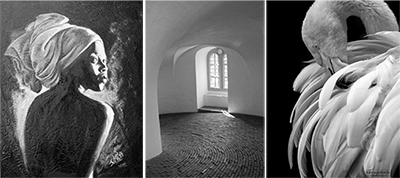
Why black and white? Since the introduction of color photography, people have questioned the aesthetics of black and white. But artists in all media continue to return to a black and white palette with wonderous results.
Ask any child with a box of crayons if black and white are colors and they will invariably show you the crayons and wonder how you could be so blind. Physics however says they are not colors because they do not have a specific wavelength; white is all wavelengths and black is the absence of visible light.
Josef Albers felt that the scientific study of color had little practical value for artists because people filter color with their own conscious and subconscious associations. He said “This fact makes colour the most relative medium in art. In order to use colour effectively it is necessary to recognize that colour deceives continually.” He began his renowned study of color theory, how the perception of a color is altered by adjacent color, with black and white.
Students of design still work within Albers’ theories when learning the elements of design, beginning by creating the perfect gray scale. Removing color reduces the subject to its basic elements: contrast, shapes, and relationships. It removes distraction so that we see the skeleton of the work and any deficiencies in the design; strengthen the underlying design, add color back and you have a much more dynamic piece.
Pablo Picasso explored the use of a black and white palette throughout his life, creating extraordinarily complex and powerful works; purging color in order to highlight their formal structure. His most famous painting, Guernica, one of the most powerful antiwar paintings in history, was painted with black, white, and shades of gray. Picasso felt that a picture in colors was to be looked at, that black and white forces us to think. Guernica is intended to make the viewer imagine this terrible incident from the inside using the hidden truth of the psyche.
311 Gallery invited artists from across the country to share their explorations into the world of black and white. Their chosen media include acrylic, charcoal, chalk, clay, digital, etching, graphite, glass, gouache, ink, metals, mixed media, oil, pastel, photography, textile, watercolor, and wax. The works will draw you in and make you think.
